The picturesque village of Roubion (in Provencal, “Robione” and “Rup” means rock with cliffs) is perched like an eagle’s nest on top of a 4,380-feet high in France, cliff and surrounded by walls dating from the middle Ages. This medieval town was built on a rock ledge that protects its 125 inhabitants from cold winds. This typical village of the Haut-Pays Niçois offers a journey back through time for us, “The visitors”: “It was much more hospitable in the past, we burned entire trees. The walls and floors were covered with rugs. Not an evening went by without, jugglers, minstrels, and women”. Whatever the character of Godefroy de Papincourt, Count of Montmirail, the village of Roubion is still very welcoming, today as it was yesterday… A winding and steep road leads through a slate of red schist up to the village. We stroll with pleasure through its narrow cobbled and steep streets, lined with old houses in the style of mountain villages. I move forward and look through an old vaulted passage… The view over the village, dominated by the magnificent bell tower (with a crenelated top) of Our Lady of Mount Carmel dating from 1713. The soft sound of the water echoes in the absolute silence of the early afternoon. Moved by curiosity, I turn left in a narrow street, then on the right, to discover a superb old wash house well supplied with water and ornamented by colorful flowers. The wash house is in the style of the old stone houses. The village has several fountains and wash houses, including the famous fountain du Mouton dating from the 18th century. A light invigorating alpine breeze brushes my face, and I close my eyes. I feel transported elsewhere, into another time, a time when wash houses were named “hôtels des bavardages” (hotels of chatter), “moulins à paroles” (mills with words) or simply “women’s parlor”. They were meeting places for the women of the villages. With repetitive gestures, these “water hens” beat, rubbed, rinsed and spun the clothes while chatting, singing or gossiping. I can almost still feel the intoxicating smell of soap… Chatter and little family secrets revealed themselves, “ici on lave le linge et on salit le monde“ (“here we wash the linen and dirty the world”) !

The village of Roubion perched like an eagle’s nest
I suddenly open my eyes and the magic evaporates. I walk away from the wash house towards the old ramparts. As I pass through a vaulted door, I discover the pretty little Chapel of Notre-Dame with its bronze bell. Below the village is another must-see chapel, the Chapel of San Sebastián, which contains well-preserved murals from the 16th century. In front of the ancient ramparts, which protected against wolves, several monuments still make it possible to imagine the life of the past. These include two round towers (which are not called Orthanc and Minas Morgul), probably vestiges of the old feudal castle. Finally, we stroll the streets of the village of Roubion and explore the alcoves and wooden doors painted by the Italian artist Imelda Bassanello. These colorful paintings of imaginary figures in the costumes of the past are a lovely feast for the eyes…
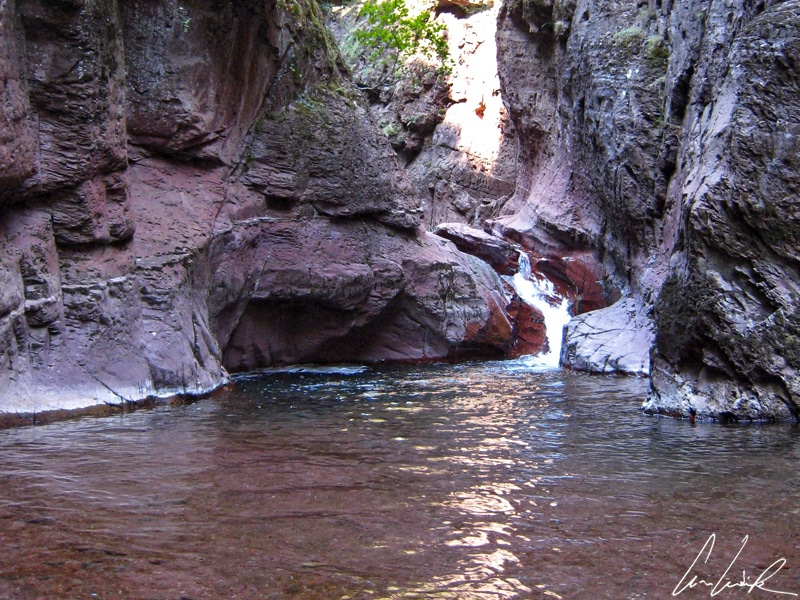
The Cians
After Roubion the schist gorges of Cians and Daluis are must-sees. The Var River and its tributary the Cians, two whitewater streams with strong flows, have shaped these deep and abrupt gorges. The dizzying vertical walls are carved in the blood-red colored Pelitic rock dating from the Permian period. Pelitic rock is composed of volcanic ash, and fine-grained sediments deposited more than 250 million years ago. The red wine like color of the gorges comes from sandstone colored by iron oxide in the Var River. These gorges offer visitors a true symphony of colors and shapes. “Fear and trembling“, how can we not to be seized by deep emotion in front of this grandiose, austere mineral landscape nicknamed the “Colorado niçois” ? The gorges of the Cians link the Var valley and the alpine pastures of the Mercantour. The Cians, a small mountain stream, has carved superb steep gorges in the red shale and limestone rock. The road follows the contours of the rock, sometimes along the stream and sometimes at the top of the gorges. It is agreeable to stop and enjoy the freshness of the Cians and the beauty of the “Deep Purple” rock(s) showing the rich geological history of a few million years. The gorges of Daluis is even more imposing and more flared than the gorges de Cians. Formed by the River Var, they lie in a 4-mile canyon between the villages of Guillaumes and Daluis. At the deepest point, the River Var lies 890 feet below the top of the canyon walls. The clue d’Amen, cut into the pelitic rock of the Dôme de Barrot massifs, offers a splendid waterfall visible from the road. The spectacular descent between the gorges of Daluis offers delight and thrills to rafting and canoeing enthusiasts. The most courageous can complete their aquatic exploit with a bungee jump from the 263-feet high Pont de la Mariée (“Bridal bridge”).

Gorges of Daluis, a 4-mile canyon
Change of scenery… on the Tende hillside along the Italian border, one of the most magnificent corners of the Mercantour, lies the Vallée des Merveilles (Valley of wonders) and Fontanalba with 40,000 rock engravings. The medieval village of Tende has passed back and forth from French to Italian control. It last became part of France only in 1947 after the Italian defeat. The Vallée des Merveilles and Fontanalba are accessible only by an unpaved road… but visiting this isolated site is well worth it. It is located between 6,900 and 8,900 feet above sea level, along the summits of the Alps. Surrounding Bégo Mountain at 9,423 feet, you discover a mineral landscape sculpted by melting glaciers, a chaotic mass formed of rugged mountain rocks in the shade of blue, red and green. By being attentive and discreet, you might see the athlete of the nevés (the chamois) and the virtuoso of climbing (the ibex) pacing the alpine meadow… Of course you are more likely to be seen by than to see one of these athletes, but if you look carefully, you may see at the crossroads of a path a marmot come out of the bottom of his burrow and whistle three times (a daily routine) to warn the colony of potential danger you represent. The landscape is also dotted with mountain lakes with black waters and bordered by peat bogs and moraines. These include the Long, Fourcat and Muta lakes Finally, the picture will be incomplete without the natural fireworks of the surrounding flora, including blue thistle, genépi, lily, gentian, orchids, houseleek, etc. Did you know that the houseleek is a medicinal plant of very ancient origin… its crushed fresh leaves can be used to treat warts, horns, insect bites, and superficial wounds. More legendary and mysterious, in the old days, houseleek was being planted on rooftops to protect the house from lightning, “spell-casters” and fire and to ensure a long life !
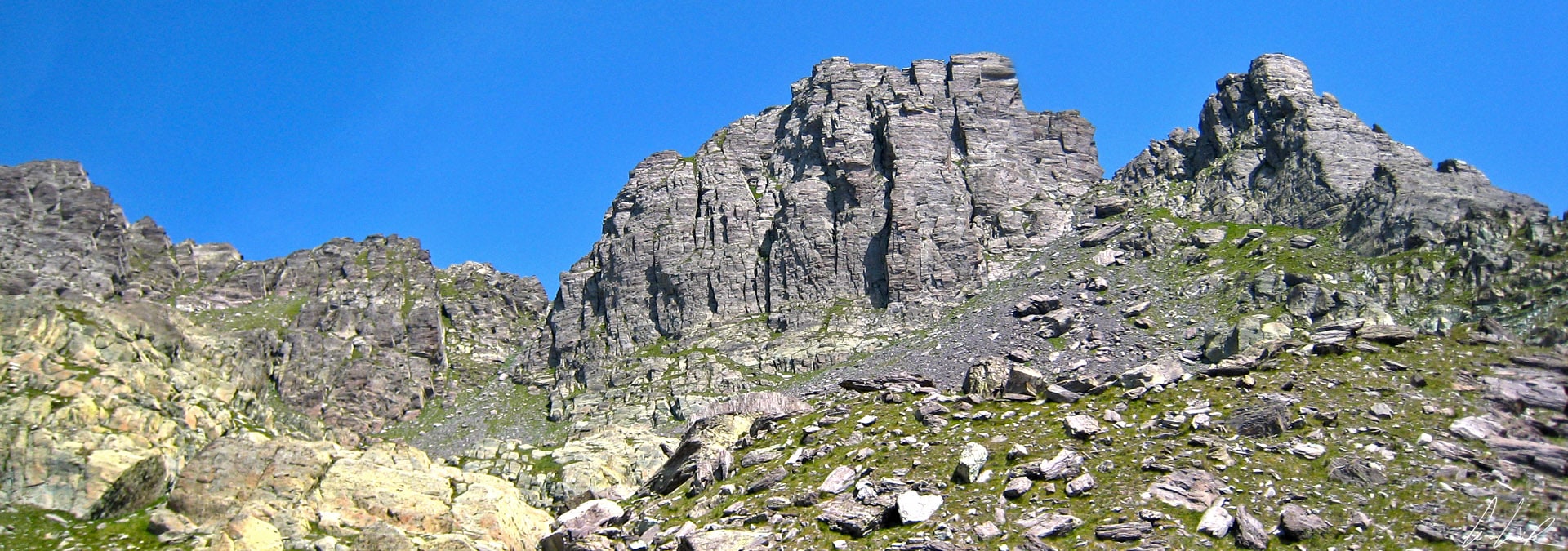
Vallée des Merveilles (Valley of wonders)
Beyond its beauty, the Vallée des Merveilles and Fontanalba contain some 36,000 open-air Bronze and early Copper Age petroglyphs dating from 3,200 to 1,700 BC, a tremendous archaeological treasure. In total, more than 40,000 engravings have been counted throughout the site, making it the largest collection of rock carvings in Europe ! The large colored shale slabs of the valley, polished by glaciers serve as a support for the incredible engraved images, although some have unfortunately been damaged. They were first identified by British archeologist Clarence Bicknell in 1881. These petroglyphs are spread over 4,000 rocks called “ciappes”. This archaeological treasure extends over a total area of 15 square miles with the greatest concentration in a 6 square mile area. In 1989, the site was classified as a Historical Monument. The engraved figures, their repeated associations, their compositions and their constructions evoke an elaborate symbolic language and have still not yet been deciphered. What significance can be attributed to these thousands of signs skillfully engraved and combined signs ? The schematic figures of harnesses, horned beasts, daggers, and people look like the simplified images that were the origin of the first Mediterranean writing that appeared in the 3rd and 4th millennia BC. These engravings, which are attributed to the tribes of Lombardy and the Rhone Valley, might express the preoccupations of the Alpine peoples, whose life was dependent to the clemency of heaven and earth for the health of their crops and herds. Were the many springs and lakes of the region seen as the Promised Land ? The slope of Bégo Mountain displays the highest density of engravings. Was it a sacred site ? Everything leads us to believe so, but nothing is certain… Today there are only hypotheses, and this place is still far from having delivered all its fascinating secrets… And so much the better… The Vallée des Merveilles and Fontanalbe remain today a unique setting for unforgettable excursions amid engravings of all historical eras. These petroglyphs offer us a true story in a natural environment under the open sky…
Discover my others articles about France
- Normandy, between “War and Peace”
- Looking back at the beaches of Normandy on D-Day
- A journey in the Mercantour…



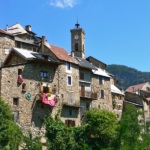



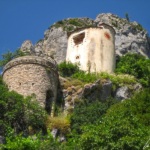
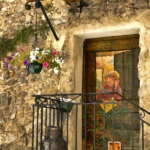


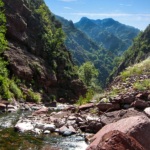
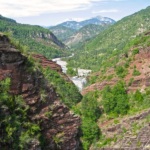
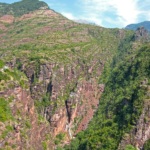
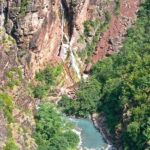
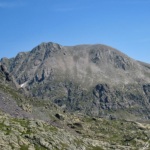


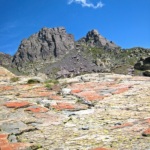
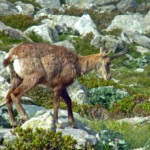
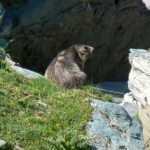
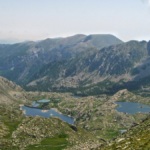
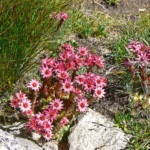
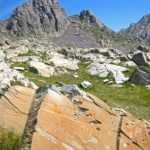
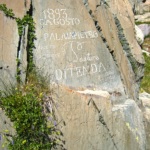
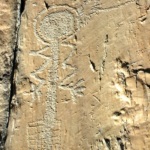


I’ve never even heard of this place before! But it sounds like such a captivating and magical place to visit. You’ve really sparked my interest.
If you are looking for a gateway into the French Alps that combines mountains, culture, and sunshine, then the Mercantour National Park is your destination 😉
I had never heard of this area but it is really beautiful and so fascinating to hear all the history. Would love to visit one day. Pinned for future reference.
This area is stunning ! These petroglyphs offer us a true story in a natural environment under the open sky… 😉
Pictures speak for you always!… You take fab pics on your travels. The village of Roubion really looks as though perched like an eagle’s nest! Pinned your post!
Thank you 🙂 Roubion is one of these typical villages of the Haut-Pays Niçois which offers a journey back through time… It’s really a pleasure to discover its narrow cobbled and steep streets, lined with old houses in the style of mountain villages !
What a magical post! I’ve never heard of this place before, will have to do more research to add this to my travel list.
The “Vallée des Merveilles” is really a unique setting for unforgettable excursions. Whether you are a botanist, a hiker, a history enthusiast, or a simple Sunday walker, there is something for you in the park 😉
Wow Celine! I’ve never been in the Parc Nationale du Mercantour, but reading this I felt like I was actually there in les moulins à paroles, right up to the petroglyphs on the ciapes. Next time I come back to France, I’m definitely going there!
These places have remained unspoiled, maintaining their wealth of natural beauty. That brings visitors back time and time again 🙂
This looks and sounds very interesting. I must go one day!
With it’s unbelievably small villages and breathtaking natural allures, the Mercantour should be on your bucket list. If it’s not, it soon will be…
WOW! This is gorgeous! I’ve never even heard of it, but it seems like a must-see! 🙂
The Mercantour massif enjoys a special place between sea and mountain. It is an outstanding destination which is worth visiting !
In France I’ve only been to Paris, and reading your article makes me soooo wanna come back and explore other parts of France as well such as the Mercantour. The landscape looks absolutely stunning from your photos! It’s good that you’ve also shared lots of useful info about this area as well. Totally love it and thanks for sharing!
France offers a wide choice of destinations, whether you’re looking for a holiday 🙂 This incredibly varied country is home to landscapes, regions, cultures and sites which are as different one from another as they are interconnected.
I’m such a lover of France and French culture, but it’s rare that we hear about more “rural” areas such as these. I’m so glad you’ve introduced me to these beautiful, beautiful regions (did you take these photos?! They’re amazing!). Thanks for some new additions to my travel bucket list. 🙂
Christie’s Take on Life. xx
Je n’ai jamais entendu de cet endroit. Mais c’est absolument merveilleux et plein de surprises. Aussi, j’adore cet adage: “voilà, on lave le linge et apaise le monde”!
Haven’t heard of this place until this post, and OMG how beautiful this is! As great as your pictures are, I’m sure the beauty is even better in person.
This is the first I’ve heard of this place, and I’m stunned by how beautiful it is. You’ve taken some wonderful pictures of the mountains.
Sophie | MapleTreeBlog
Splendid, it looked so beautiful. All the more picture perfect for photographers. Loved the mountain with stream pic the most.
Wow just loving this place. All pictures looks so fascinating and eye catching. Looks like wonderful creation of god. Love the beauty of nature. Thanks for sharing this beautiful place.
Enjoyed learning about this new village in France – the location is unique, wrapped around that mountaintop! Thanks for sharing.
Sarah
I love finding new travel blogs. I do more road trips and cruises, but always add these to my bucket list. Great photos.
i’ve never even heard of this place before! But it sounds like such a captivating and magical place to visit.
Wonderful pictures. I have not been to France before, but this post has gotten me interested. Everything looks so beautiful. Thanks for sharing!
Oh dear, I envy your experience! I would love to do the same! For the meantime I will save this and look forward for a holiday leave vacation and let’s see I will visit this too!
This place is totally new to me. I would love to go one day. I love all the natural beauty entwined in everything.
This looks straight out of a postcard! I wish to visit this place one day as it holds a lot of natural landmarks and beautiful scenery <3
I have to admit that I have never heard of this place but it looks absolutely splendid! Your pictures speak for itself how beautiful this destination is!
This is the first time I came across of this place,it looks stunning.these photos are amazing and creates beautiful moments.I’d love to visit there one day!